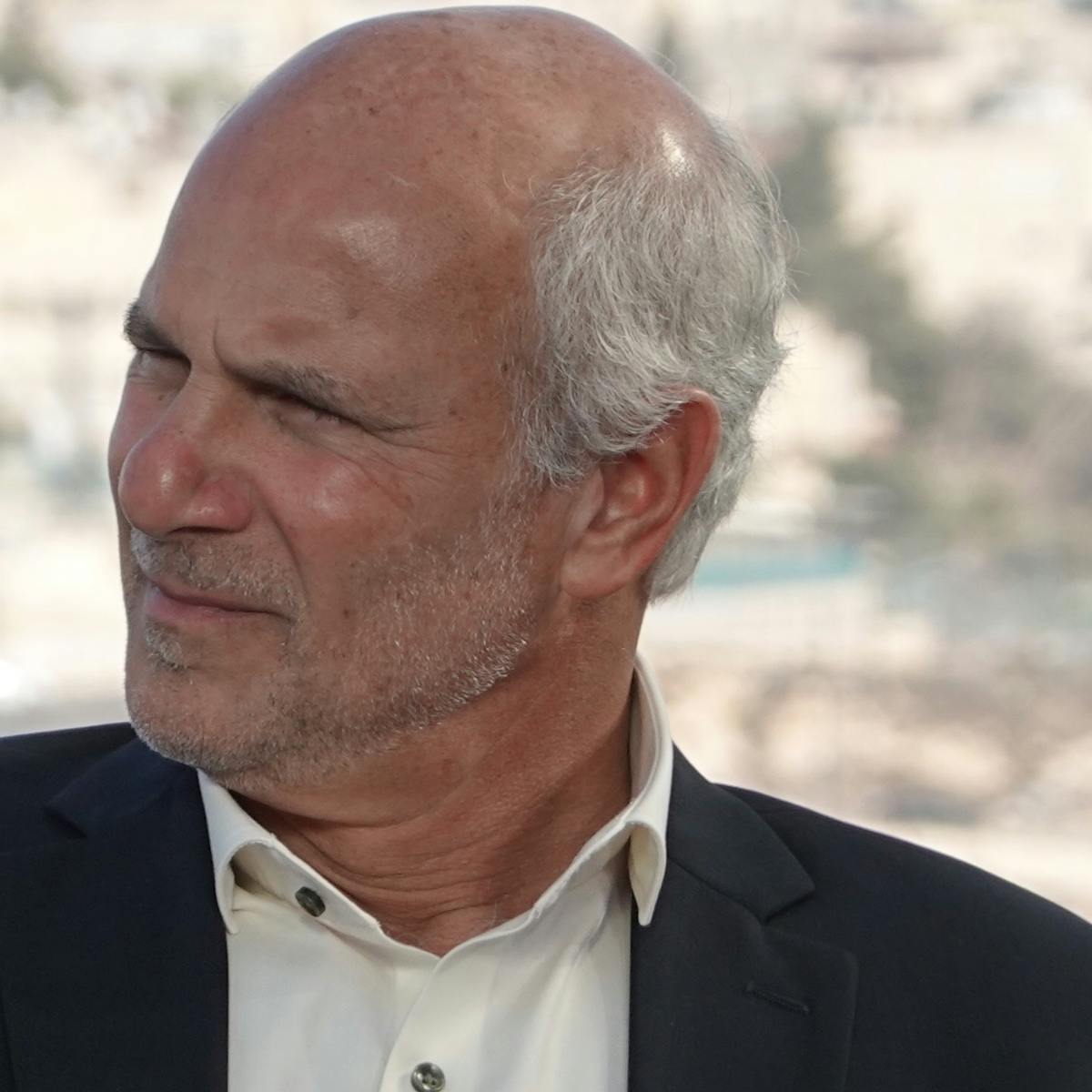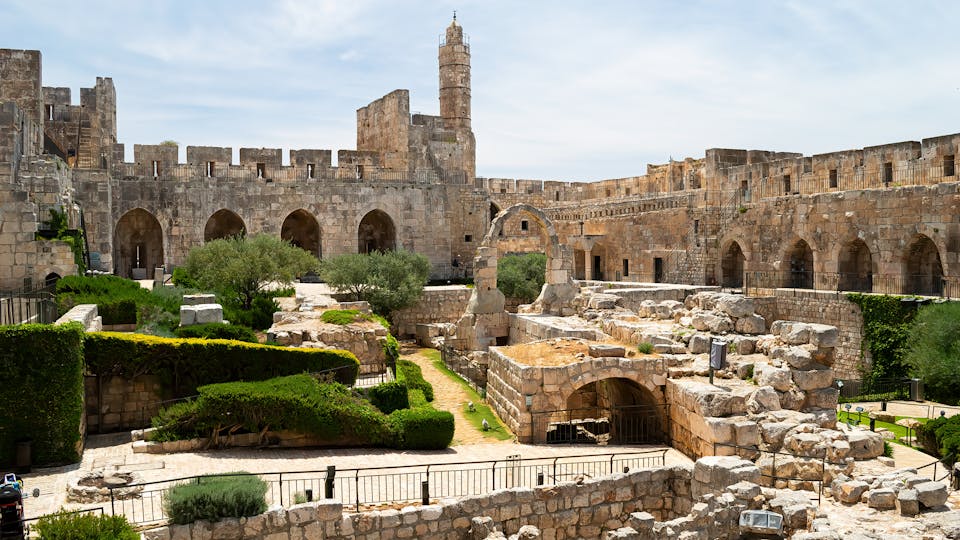Explore the Historic Tower of David: A Journey Through Time

The Tower of David, renowned for its historical and biblical importance, beckons travelers from all corners of the globe and is a popular site for many Sar-El Tours groups who arrive in the Holy Land.
While the name evokes a natural connection to King David, it's important to clarify that King David himself, who lived and served God a thousand years before the original citadel was built, had no hand in the construction of this iconic structure.
The True Architect: King Herod the Great

The Tower of David, renowned for its historical and biblical importance, beckons travelers from all corners of the globe and is an often-visited site for many of our Sar-El Tours’ groups who arrive to the Holy Land on faith journeys.
While the name evokes a natural connection to the historic and fascinating figure King David, it's important to clarify that King David himself, who lived and served God a thousand years before the original citadel was built, had no hand in the construction of this iconic structure.
The true visionary behind the fortress and its three intimidating towers was none other than King Herod the Great, the prolific architect/builder who is known for his grand projects in the land of Israel. His building projects included the formidable fortress of Masada by the Dead Sea, the stunning city of Casearia Maritima on the coast of the Mediterranean, and the lavish Herodion wilderness palace east from Bethlehem.
During the first century BC, just a few years before the birth of Yeshua (Jesus) of Nazareth, King Herod the Great was obsessed with making a name for himself while securing his position before his Roman handlers and fortifying his capital city, Jerusalem.
Consequently, he embarked on a monumental task — the construction of a massive fortress at Jerusalem’s western gate that would echo through the ages. Three impressive towers, rising majestically over the mountainous landscape, would offer a commanding vantage point and grant the defenders complete control over the surrounding region.
This fortress, a testament to Herod's architectural prowess and thirst for fame is standing in Jerusalem until today, and has become a symbol of his rule and legacy down the many generations to come.
Bridging History: The Tower's Role in Biblical Narratives
Among the tower's most intriguing connections to the biblical narrative (and especially as it relates to its most important visitor, Jesus of Nazareth) is its association with the person of Pontius Pilate, a pivotal figure in biblical history who governed the province of Judea during the time of Jesus.
During recent decades, many biblical scholars and archeologists arrived at the opinion that the Tower of David may very well be the site of the Praetorium, the judgment seat where Pontius Pilate tried Jesus of Nazareth at the behest of the Jewish leadership, found him guilty of sedition, and condemned Him to death on a Cross.
The reason for this scholarly conclusion regarding the tower’s placement in the story of Jesus’ trial and consequent brutal execution is related to the fact that historians came to believe that Pontius Pilate, whose permanent residence was in Casearia Maritima on the coast, was actually hosted as a guest of honor in Herod’s Palace at the Citadel during his formal visits to Jerusalem.
Previous traditions placed the Roman Governor at the Jerusalem Roman garrison with his troops, but, as mentioned above, that view has changed due to the discovery of what is believed to be Herod the Great’s palace at the excavations of the Tower of David.
Therefore, placing Pontius Pilate at Herod’s Palace (the present-day Tower of David Citadel) during the Passover Feast and the trial of the century (both were national events for which the Roman Governor was present), suggests that it was there that Pilot held court and tried Jesus as described in the Gospel of John chapter 18.
Some archeologists have gone as far as identifying the actual Praetorium and its stone pavement which was located on the western end of Herod’s palace which, according to research, the Roman officials were accustomed to appropriate and occupy whenever they came from Caesarea to Jerusalem transact public business.
This biblical and archeological connection lends the Tower of David an unparalleled significance to people of faith from all over the world as it stands as a timeless witness to one of the most transformative moments in human history.
Through the Sands of Time: The Tower's Resilience
Over the millennia, empires have risen and fallen, leaving their indelible imprints on the City of Jerusalem in general and on the Tower of David in particular. Always serving as a dominant military fortress, the Romans, Byzantines, Arab Muslims, Crusaders, Mamluks, Turks, the British Empire and finally Israel, all played their parts in the ongoing shaping of this historic monument. Each era added layers to the tower's architecture and narrative, crafting a tale that speaks of resilience, endurance, and the relentless passage of time.
Nearly 1,900 years following the famous trial held on those grounds, a momentous occasion occurred on December 9th, 1917, when Jerusalem was liberated from the Islamic Ottoman rule by the British Expeditionary Forces that swept the region during WW1. Arriving from Northern Africa and fighting their way northward, the British and Allied forces defeated the Ottoman Empire which was in league with the Germans and liberated the Holy Land.
The political end game behind this military victory, as described in the famous Balfour Declaration (a formal position paper published by the British Government), was to secure and prepare the Land of Israel (called Palestine at that time) to be the national home for the Jewish people.
The commanding British officer, General Allenby, is famously remembered for his historic entrance through the Jaffa Gate into Jerusalem to receive the key for the city from the surrendering Ottoman Governor on December 11.
Eye witnesses described the conquering General, the very first Christian in many centuries to control Jerusalem, dismounting his horse before arriving at the historic gate next to the Tower of David, and walking into the city of foot, saying, “I will not ride my horse where my Savior walked.” The Prime Minister of the UK, David Lloyd George, described Jerusalem’s capture as “A Christmas present for the British people.”
This surrender ceremony that took place on the ramparts of the Tower of David fortress not only liberated Jerusalem from centuries of Muslim occupation, but also rekindled the use of the Hebrew language as a formal and recognized language in international communications, setting the stage for a new era in Jerusalem's epic and turbulent history.
A Beacon of Promise: Towering Over Jerusalem
Fast forward to December 11th, 1967, a date etched in history during the miraculous and famous Six-Day War in which the young State of Israel defeated all the surrounding Arab armies coming against it while claiming the territories of the Sinai Peninsula, Judea, Samaria, East Jerusalem, and the Golan Height during six days of lightning speed warfare.
On this very day, Jerusalem was fully liberated including the Temple Mount, and reclaimed its historic sovereignty as the Israeli national flag was raised atop the Tower of David. This symbolic act represented the city's unyielding legacy as God’s chosen place of worship as promised since the days of Moses, Abraham and David, and its unwavering connection to its biblical roots.
Echoing through time, the words of the ancient prophet Zechariah still resonate, saying, “Jerusalem shall dwell where Jerusalem always dwelt.” (Zechariah 12:6). As many of our Sar-El Tours’ pilgrims experience, this enduring presence underscores the divine faithfulness, and is a testament to the veracity of God’s promises as an embodiment of the city's enduring legacy in God’s plan and purpose.
Unveiling Layers: Exploring the Tower's Archaeological Marvels
Beneath its surface, the Tower of David houses a trove of archaeological treasures. It offers a window into the era of King Herod the Great and his dynasty, showcasing his architectural genius alongside his ambitions.
The Citadel’s main tower which is ascended by many of our Sar-El Tours’ visitors who are able to brave its many steps, offers fantastic panoramic vistas of Old and New Jerusalem, the Temple Mount, the Dead Sea region, and the tribal lands of Judah. It stands tall and solid as a testament to Herod's vision and to the city's historical importance.
Today, visitors enjoy the famous light and sound dramatic shows that tell the epic story of the city down through the ages; explore the interactive galleries that bring to life the city’s biblical significance; and ponder afresh the full meaning of the story of Jesus, His trial, death, and resurrection.
Frequently Asked Questions
1. Who built the Tower of David?
- The Tower of David was built by King Herod the Great in the first century BC. It was not constructed by King David, despite the name.
2. Why is the Tower of David significant?
- The Tower of David is significant for its historical and biblical connections, including its possible association with the trial of Jesus by Pontius Pilate.
3. What can visitors see at the Tower of David?
- Visitors can explore the ancient and medieval structures, enjoy panoramic views from the Phasael Tower, and experience light and sound shows that tell the story of Jerusalem through the ages.
4. How has the Tower of David been used throughout history?
- Throughout history, the Tower of David has served as a military fortress for various empires, a residence for governors, and now a museum and cultural site.
The Tower's Timeless Legacy
The Tower of David is not merely a relic of the past but a living testament to history's profound impact. It stands as a beacon of faith, a symbol of God's faithfulness, and a reminder of the eternal thread that ties the past to the present and future.
We look forward to welcoming you to the Tower of David in person, where history comes alive and the Spirit of God whispers to the heart of the faithful through the ancient stones.
From all of us at Sar-El Academy, Sar-El Tours, and Sar-El Media, we extend our warmest regards, awaiting the day when you can stand in the shadow of this historic tower and experience its magic firsthand.
Shalom and may your journey be blessed!